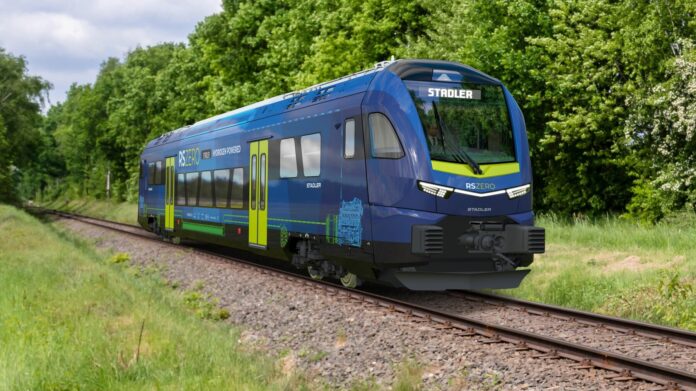Stadler has unveiled the prototype of the new RS ZERO, the innovative successor to the successful RS1 Regio-Shuttle. The Regio-Shuttle has been one of the most popular vehicles in German regional rail transport for 28 years, with around 500 RS1 vehicles currently in operation in Germany and the Czech Republic. Stadler is building on this proven technology and integrating state-of-the-art, environmentally friendly drive systems. The RS ZERO is optionally available with a hydrogen and/or battery drive and thus not only sets new standards for environmentally friendly rail transport, but also presents a world first.
A symbol of progress
The RS ZERO stands for continuity and innovation. Stadler is continuing the success story of the RS1 and at the same time meeting the challenges of the present with the new, sustainable powertrains. The RS ZERO retains the characteristic trapezoidal window strips of the RS1 and blends into the futuristic design with a modern LED wing.
“The Regio-Shuttle RS1 is an important part of Stadler’s history. We delivered the last vehicle to a customer 11 years ago. Now I am delighted that we start a new chapter in this success story with the RS ZERO which enables us to further expand our technological leadership in the field of alternative drive technologies,” says Peter Spuhler, Chairman of the Board of Directors of the Stadler Group.
Technological openness and sustainability
In Germany, 38 per cent of railway lines are not electrified, in Europe the figure is as high as 43 per cent. The transport transition also aims to shift significantly more traffic to rail – to achieve this, old and non-electrified lines need to be reactivated in Germany and Europe. With its battery and hydrogen drives, the RS ZERO offers a solution for locally CO2 emission-free operation on these routes. It makes no difference whether they are electrified or require hydrogen refuelling stations or charging islands. Each vehicle can be adapted to the respective conditions of the rail network. Thanks to its lightweight design and an axle load of less than 18 tonnes, it is ideally suited to creating an economically attractive transport service even on secondary routes with low traffic density.
“With the RS ZERO prototype we are very proud to build the next vehicle with alternative drive technology at the Berlin site after the battery-electric FLIRT Akku,” explains Jure Mikolčić, CEO of Stadler Germany. “Thanks to our technological openness, we can always offer our customers the right vehicle and make an important contribution to the transport transition.”




